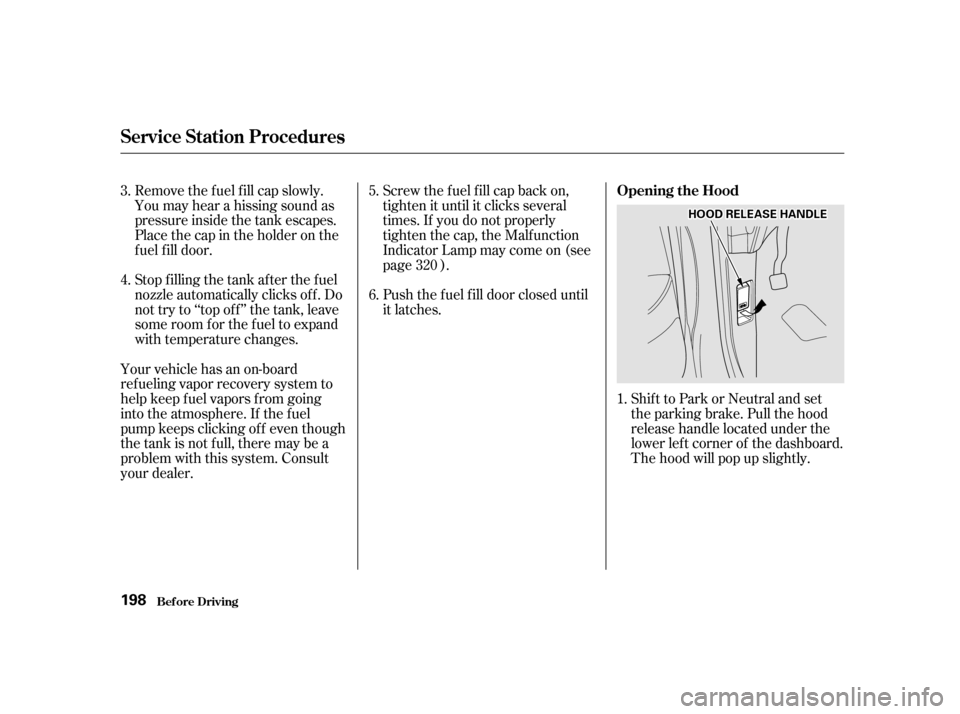Page 4 of 363

This section gives you important
inf ormation about how to protect
yourself and your passengers. It
shows you how to use seat belts
properly. It explains your Supple-
mental Restraint System. And it tells
you how to properly restrain inf ants
and children in your vehicle..........
Important Safety Precautions . 6
.......
Your Vehicle’s Saf ety Features . 7
.......................................
Seat Belts . 8
...........................................
Airbags . 9
.....................
Seats & Seat-Backs . 10 ..........................
Head Restraints . 10
..................................
Door Locks . 10
........
Pre-Drive Saf ety Checklist . 11
............................
Protecting Adults . 12
.....
1. Close and Lock the Doors . 12
...........
2. Adjust the Front Seats . 12
............
3. Adjust the Seat-Backs . 13
...
4. Adjust the Head Restraints . 14
5. Fasten and Position the Seat
.....................................
Belts . 15
....
6. Adjust the Steering Wheel . 19
7. Maintain a Proper Sitting
................................
Position . 19
.....
Advice f or Pregnant Women . 20
...
Additional Safety Precautions . 20
........................
Protecting Children . 22
All Children Must Be ...............................
Restrained . 22
Children Should Sit in the Back ...........................................
Seat . 23
The Passenger’s Airbag Poses ......
Serious Risks to Children . 24
If You Must Drive with Several ...................................
Children . 26
If a Child Requires Close ..................................
Attention . 26 ...
Additional Safety Precautions . 27
General Guidelines f or Using
...............................
Child Seats . 28
.......................
Protecting Inf ants . 32
.........
Protecting Small Children . 37
.......
Protecting Larger Children . 41
Using Child Seats with
.....................................
Tethers . 45
...
Using the Lower Anchorages . 47
Additional Inf ormation About Your .................................
Seat Belts . 49
..
Seat Belt System Components . 49
......................
Lap/Shoulder Belt . 49
...............
Seat Belt Maintenance . 51
Additional Inf ormation About Your
...........................................
SRS . 52
........................
SRS Components . 52
...........
How Your Airbags Work . 52
How the Automatic Seat Belt
....................
Tensioners Work . 54
How the SRS Indicator Light .......................................
Works . 54
..................................
SRS Service . 55
...
Additional Safety Precautions . 56
.............
Carbon Monoxide Hazard . 57
...................................
Saf ety Labels . 58
Driver and Passenger Saf ety
Driver and Passenger Saf ety 5
Page 54 of 363

Your Supplemental Restraint System
is virtually maintenance-f ree, and
there are no parts you can saf ely
service. However, you must have
your vehicle serviced if :The
airbags, seat belt tensioners, and
control unit must be replaced. Do
not try to remove or replace the
airbags yourself .
This must be done by a Honda
dealer or a knowledgeable body
shop.
Take your vehicle to
an authorized Honda dealer as
soon as possible. If you ignore this
indication, the airbags might not
inf late when you need them (see
page ).
If the light comes on or f lashes on
andoff whileyoudrive.
If you see any of these indications,
your airbags and seat belt tensioners
may not deploy when you need them.
See your Honda dealer as soon as
possible.
54
SRS Service
Your airbags ever inf late.
T he SRS indicat or light alert s yout o a problem.
Additional Inf ormation About Your SRS
Driver and Passenger Saf ety 55
Ignoring the SRS indicator light
can result in serious injury or
death if the airbags do not
inflate when needed.
Have your vehicle checked by a
dealer as soon as possible if
the SRS light alerts you to a
potential problem.
Page 194 of 363
Bef ore you begin driving your Honda,
youshouldknowwhatgasolineto
use, and how to check the levels of
important f luids. You also need to
know how to properly store luggage
or packages. The inf ormation in this
section will help you. If you plan to
add any accessories to your vehicle,
please read the inf ormation in this
section f irst..............................
Break-in Period . 196
.........................................
Gasoline . 196
.........
Service Station Procedures . 197
................
Filling the Fuel Tank . 197
....................
Opening the Hood . 198
...............................
Oil Check . 200
.........
Engine Coolant Check . 201
...............................
Fuel Economy . 202
.....................
Vehicle Condition . 202
...........................
Driving Habits . 202
...
Accessories and Modif ications . 203
.............................
Carrying Cargo . 205
Bef ore Driving
Bef ore Driving 195
Page 196 of 363
Because the f uel f ill cap is on the
driver’s side of the vehicle, park
with that side closest to the
service station pumps.
Open the f uel f ill door by pulling
onthehandletotheleftof the
driver’s seat.
In Canada, some gasolines contain
an octane-enhancing additive called
MMT. If you use such gasolines,
your emission control system
perf ormance may deteriorate and
the Malf unction Indicator Lamp on
your instrument panel may turn on.
If this happens, contact your
authorized Honda dealer f or service.
Bef ore ref ueling, make sure the rear
sliding door on the driver’s side is
closed.
1. 2.
CONT INUED
Bef ore Driving
Filling the Fuel Tank
Gasoline, Service Station Procedures
197
PPuullll
FFUUEELLFFIILLLLCCAAPP
Gasoline is highly flammable
and explosive. You can be
burned or seriously injured
when handling fuel.
Stop the engine and keep
heat, sparks, and flame away.
Handle fuel only outdoors.
Wipe up spills immediately.
Page 197 of 363

Remove the f uel f ill cap slowly.
You may hear a hissing sound as
pressure inside the tank escapes.
Place the cap in the holder on the
fuel fill door.
Stop f illing the tank af ter the f uel
nozzle automatically clicks of f . Do
not try to ‘‘top off’’ the tank, leave
some room f or the f uel to expand
with temperature changes.Shift to Park or Neutral and set
the parking brake. Pull the hood
release handle located under the
lower lef t corner of the dashboard.
The hood will pop up slightly.
Screw the f uel f ill cap back on,
tighten it until it clicks several
times. If you do not properly
tighten the cap, the Malfunction
Indicator Lamp may come on (see
page ).
Push the f uel f ill door closed until
it latches.
Your vehicle has an on-board
ref ueling vapor recovery system to
help keep f uel vapors f rom going
into the atmosphere. If the fuel
pump keeps clicking of f even though
the tank is not full, there may be a
problem with this system. Consult
your dealer. 1.
3. 4.
5. 6.
320
Service Station Procedures
Bef ore Driving Opening the Hood
198
HHOOOODDRREELLEEAASSEEHHAANNDDLLEE
Page 198 of 363
CONT INUED
Pull the support rod out of its clip
and insert the end into the hole on
the driver’s side of the hood.
If you can open the hood without
lifting the hood latch handle, or the
hood latch handle moves stif f ly or
does not spring back as bef ore, the
mechanism should be cleaned and
lubricated (see page ).
Standing in f ront of the vehicle,
put your f ingers under the f ront
edge of the hood. The hood latch
handle is above the ‘‘H’’ logo. Pull
up on this handle until it releases
the hood. Lif t the hood. 3.
264
2.
Service Station Procedures
Bef ore Driving 199
SSUUPPPPOORRTTRROODD
LLAATTCCHH
Page 199 of 363
Wipe the dipstick with a clean
cloth or paper towel.
Check the engine oil level every time
you f ill the vehicle with f uel. Wait a
f ew minutes af ter turning the engine
of f bef ore you check the oil.
Remove the dipstick (orange
handle).
To close the hood, lif t it up slightly to
remove the support rod f rom the
hole. Put the support rod back into
its holding clip. Lower the hood to
about a f oot (30 cm) above the
fender,thenletitdrop.
Afterclosingthehood,makesureit
is securely latched.
2.
1.
Service Station Procedures
Bef ore Driving
Oil Check
200
DDIIPPSSTTIICCKK
Page 200 of 363
Refer toon page f or inf ormation
on checking other items in your
Honda.
Look at the coolant level in the
radiator reserve tank. Make sure it is
between the MAX and MIN lines. If
it is below the MIN line, see
on page f or
informationonaddingtheproper
coolant.
If it is near or below the lower mark,
see on page .
Insert it all the way back in its tube. Remove the dipstick again and
check the level. It should be
between the upper and lower
marks.
4.
3.
247
249
253
Bef ore Driving
Service Station Procedures
Owner Maintenance
Checks A dding
Engine Coolant
A dding Oil
Engine Coolant Check
201
UUPPPPEERRMMAARRKK
LLOOWWEERRMMAARRKK
MMAAXX
MMIINN
RREESSEERRVVEETTAANNKK